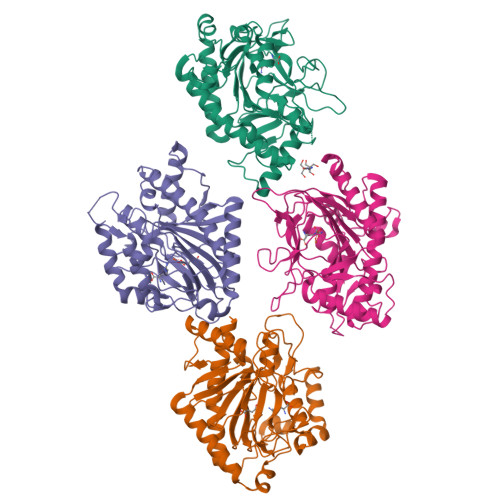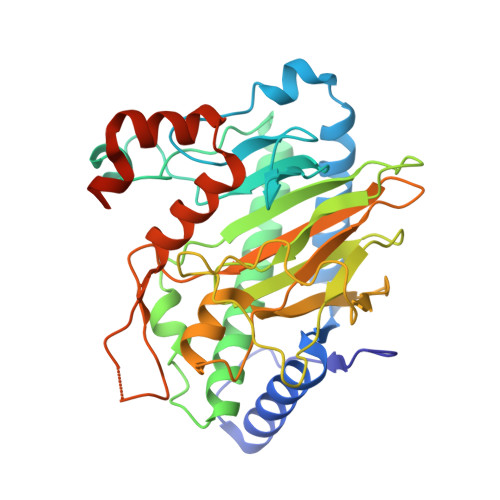An Iron(IV)-Oxo Intermediate Initiating l-Arginine Oxidation but Not Ethylene Production by the 2-Oxoglutarate-Dependent Oxygenase, Ethylene-Forming Enzyme.
Copeland, R.A., Davis, K.M., Shoda, T.K.C., Blaesi, E.J., Boal, A.K., Krebs, C., Bollinger Jr., J.M.(2021) J Am Chem Soc 143: 2293-2303
- PubMed: 33522811
- DOI: https://doi.org/10.1021/jacs.0c10923
- Primary Citation of Related Structures:
6VP4, 6VP5 - PubMed Abstract:
Ethylene-forming enzyme (EFE) is an ambifunctional iron(II)- and 2-oxoglutarate-dependent (Fe/2OG) oxygenase. In its major (EF) reaction, it converts carbons 1, 2, and 5 of 2OG to CO 2 and carbons 3 and 4 to ethylene, a four-electron oxidation drastically different from the simpler decarboxylation of 2OG to succinate mediated by all other Fe/2OG enzymes. EFE also catalyzes a minor reaction, in which the normal decarboxylation is coupled to oxidation of l-arginine (a required activator for the EF pathway), resulting in its conversion to l-glutamate semialdehyde and guanidine. Here we show that, consistent with precedent, the l-Arg-oxidation (RO) pathway proceeds via an iron(IV)-oxo (ferryl) intermediate. Use of 5,5-[ 2 H 2 ]-l-Arg slows decay of the ferryl complex by >16-fold, implying that RO is initiated by hydrogen-atom transfer (HAT) from C5. That this large substrate deuterium kinetic isotope effect has no impact on the EF:RO partition ratio implies that the same ferryl intermediate cannot be on the EF pathway; the pathways must diverge earlier. Consistent with this conclusion, the variant enzyme bearing the Asp191Glu ligand substitution accumulates ∼4 times as much of the ferryl complex as the wild-type enzyme and exhibits a ∼40-fold diminished EF:RO partition ratio. The selective detriment of this nearly conservative substitution to the EF pathway implies that it has unusually stringent stereoelectronic requirements. An active-site, like-charge guanidinium pair, which involves the l-Arg substrate/activator and is unique to EFE among four crystallographically characterized l-Arg-modifying Fe/2OG oxygenases, may serve to selectively stabilize the transition state leading to the unique EF branch.






















